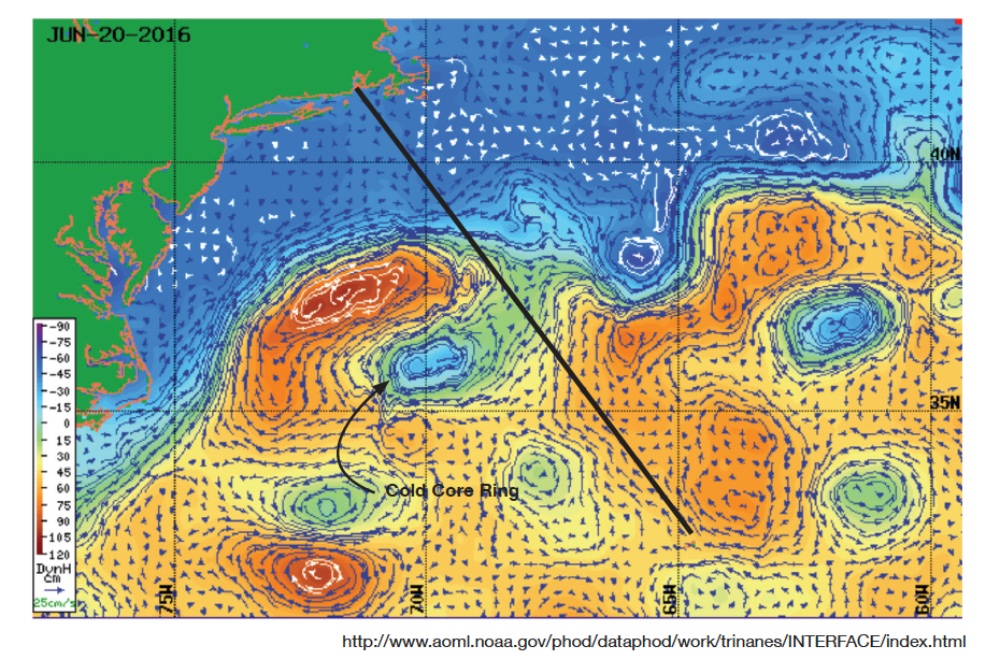Skippers and navigators can learn lessons about both Gulf Stream and weather forecasts with a look back at the last race. Story by W. Frank Bohlen.
It has been said that races are won in preparation and lost on the water. If you’re navigating a Newport Bermuda Race, your pre-race activities begin months beforehand with a careful check of navigational instruments including the GPS, AIS, water temperature sensors, and barometer with particular attention to the wind speed and direction and the in-water boat speed sensors. These checks extend to associated shipboard communications systems (VHF, SSB, and satphone) as well as to the compatibility of the sensor suite with the selected navigational or routing programs. Instrument calibration will be one of the primary chores during the first sail of the season.

You’ll also benefit from a careful review of weather and Gulf Stream conditions experienced in past Races. Focus on actual conditions, including rates of change, and the accuracy of the forecasts or models. This combination provides a valuable indication, particularly for first-time participants, of the character of the Newport Bermuda Race and its navigational challenges, much the way a type of music defines the dance.
Gulf Stream Shift
The 2016 Race provided a rich variety of lessons. In the case of the Gulf Stream, satellite images of sea surface temperatures in early March (Fig. 1) showed the main body of the Stream (dark red, high-temperature band) crossing the rhumb line at a point approximately 200 nautical miles from Newport. The Stream form was dominated by a number of large-amplitude meanders. An evident cold core ring was located just to the south of the main body, straddling the rhumb line with a smaller, less-defined warm feature north of the main body just east of the rhumb line.

Conventional wisdom would have these features experiencing a progressive, reasonably well-defined evolution over the 2.5-month period to the Race start (see Gulf Stream Primer under Gulf Stream Tutorials). The meanders would propagate (move) downstream towards Europe at a speed of approximately 10 to 20nm/day. In contrast, the cold and warm core rings would drift to the west at a speed of approximately 2.5nm/day. Such progression can substantially modify the speed and direction of surface currents in the vicinity of the rhumb line, directly affecting optimum routing.
Regular observation through March, April and May provided little evidence of the expected regular evolution. Stream structure changed only slightly. The main body meander varied in wavelength and amplitude but showed little regular easterly propagation. The cold core ring moved slowly to the west by approximately 60nm but remained in close contact with the rhumb line into June.

On June 15th, two days before the start, Rutgers SST image (Fig.2) showed the main body of the Stream still crossing the rhumb line at a point approximately 200nm from Newport and leading to a deep meander to the east. A warm-core feature was positioned north of the main body and east of the rhumb line. Although cloud cover obscured the cold core ring, use of the NOAA altimetry based model (see discussion of models in the 2016 Race Program or at Gulf Stream & Wx) showed the ring positioned just to the west of the rhumb line producing south- to-north-going currents over nearly 100nm of the rhumb line (Fig.3).
However, this slow progression changed radically after the start on June 17. By June 20, the cold core ring had moved to the west by more than 30nm (compare Fig. 3 to Fig.4). That’s a distance equaling nearly half of the drift observed since March.
This unusual abrupt change affected many racers who had planned strategies on the assumption that the slow-to-no drift of the ring observed over the preceding months would persist. Tracks directed at the westerly margin of the ring rather than finding weak or favorable south-going currents instead encountered adverse northerly flows often in excess of 2 knots. The lesson to learn from this is clearly that Stream evolution and the migration of meanders and rings don’t always follow simple rules. Failure to recognize this in strategic planning often comes at a cost.

Complex Weather Modeling
Reviews beginning a week before the Race suggested that the Race period June 17-21 would be dominated by high pressure and generally light winds. By June 13, however, this prognosis changed substantially. All weather models began forecasting the development of a low pressure system off Cape Hatteras with the potential to produce gale to storm force winds in the vicinity of the Gulf Stream as the fleet approached on Saturday into Sunday. The track of this low would favor east to northeasterly winds, which acting against the current in the Gulf Stream would produce rough seas with occasional breaking. These were the conditions discussed at the Skipper’s Meeting on Thursday and by private weather services to their customers on Friday morning. This combination of information and concerns regarding boat integrity and crew safety resulted in withdrawal by an unusually large number of competitors.
A review of the archived National Weather Service, Ocean Prediction Center weather charts for the Race period indicates that the weather experienced for most of the fleet differed substantially from the pre-Race forecast. (Note that use requires patience: From the Directory, select the day (e.g. “20160616” for June 16) and then scroll down to “atl” or “atlw” for “Atlantic west” to obtain surface analyses (atlw.sfcAnal) or forecasts.)

As discussed, the OPC forecast for June 20 based on the GFS weather model showed a substantial low developing off Cape Hatteras and tracked north across the rhumb line (Fig.5). This low did in fact form over the June 18 and 19 following the convergence of two low centers along a cold front. However, the system was smaller and less intense than originally forecast and moved rapidly along a northeasterly track. This favored the development of northeasterly winds along the rhumb line with speeds generally less than 25 knots. Strongest winds were along and to the east of the rhumb line with the low tracking well south of the majority of the fleet by June 20 (Fig.6). Only flyers like Comanche saw higher winds and more variant conditions, encountering squalls on approach to Bermuda associated with the cold front. Sea state conditions in the Stream were relatively benign.
The reason for the substantial difference between forecast and actual conditions cannot be simply specified. It was likely the result of several factors including upper-level conditions (see the 500mb charts for the period in the archive), the vertical structure of the atmosphere affecting systems as they move from over land to over water, and the fact that we are dealing with turbulent or chaotic flow in the atmosphere that is impossible to model definitively. This latter fact is important to remember. The models that we have of atmospheric flows—our weather forecast models—serve to specify only the “possibility” or “probability” of the occurrence of an event. They do not guarantee occurrence.
The accuracy of such models is very much dependent on the complexity of the system being modeled. A surface low tightly coupled to and steered by upper-level winds is generally modeled very accurately. However, reduce or eliminate the coupling and model accuracy falls. The formation and track of the forecast low of June 19 to 20 involved several lows, one tracking across country from the Great Lakes with a big high behind it and the other associated with a cold front. Consolidated, the system would be moving over the Gulf Stream with its abundant supply of heat and water vapor and in addition would be influenced by a deep upper-level trough favoring abundant rotation. This combination made for a very complex system that challenged the state of our modeling skills. The resulting effort did get the “big picture” right and erred only in detail. Of course for the racing sailor dealing with a narrow window in time and space, it’s often the details that matter.
The Skeptical Navigator
The conditions during the 2016 Newport Bermuda Race provide valuable lessons for future racers. The difference between expected and experienced conditions in both Gulf Stream and weather suggest that skepticism is a valuable attribute for a navigator. Don’t be afraid to question. A sound basis for questioning is best developed by personal pre-race study of Gulf Stream form and structure and the developing weather patterns. These efforts will permit reasoned questioning of any hired consultants as well as providing a basis for decision-making during the Race when conditions begin to differ from those forecast. It’s essential to remember that we are dealing with complex flows and that models do not provide definite answers, only probabilities. The weather services recognize this and have been starting to provide indication of the probability of winds of particular speeds as provided by several models (see NAEFS Probabalistic Wind Speed Guidance).
One of the challenges with this information is how to most effectively use it. Tolerance for a particular range of conditions is very much a function of the boat and crew and personal acceptance of risk. In many ways, the response of the entrants to the pre-race weather forecasts in 2016 provided clear illustration of this as well as the value of care in preparation.
The author is a CCA member and has provided Bermuda-bound fleets with Gulf Stream and weather insight since 1998. Bohlen is a Physical Oceanographer and Professor Emeritus in the Department of Marine Sciences at University of Connecticut. He has sailed 19 Newport Bermuda Races and received the Mixter Trophy as winning navigator in 1986.















































